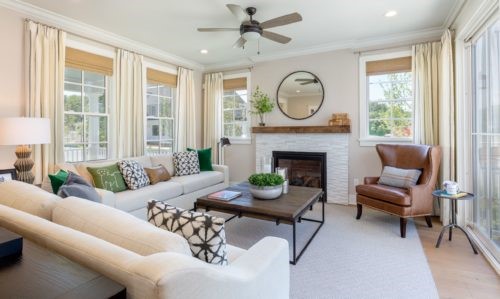In an attempt to foster greater collaboration between builders, architects and designers, Lita Dirks & Co. recently shared a list of common interior design terms. To help building industry colleagues speak the “same language.” Here are a few more common interior design terms that designers use on a fairly regular basis.
Lighting Terms
Up lighting: A light positioned so that the beam of light is directed upward. By using up lighting, you can create a unique, romantic atmosphere that cannot be reached through other types of lighting.
Ambient lighting: Refers to the light that is already present in a scene, before any additional lighting is added. Typically meaning natural light, either outdoors or coming through windows, etc.
Layering: Design approach where several types of lighting are combined to achieve a specific ambiance or mood.

Task lighting: This type of lighting is used to improve visibility in an area where specific tasks will be carried out, hence their name. For example, using lights under kitchen cabinets for food preparation.
Recessed: A recessed light fixture is designed to be installed in an opening in the ceiling. They typically have predetermined dimensions and provide overall illumination in a room or space.
Specialty/decorative: This type of lighting is included to add drama, a theme and/or interest to the environment.
(Some) Design Styles
Craftsman: Warm colors, rugged textures, and rustic finishes are all considered a part of the craftsman design. Furniture is often characterized by fine workmanship that isn’t overly ornate, and typically reflects the identity or ethnicity of the maker.
Farmhouse: This type of style is commonly associated with rugged yet refined decor. A contrast in sophistication and simplicity. The classic farmhouse evokes feelings of warmth and comfort. It’s traditional without being fussy. It’s all about mixing comfortable furniture with salvaged materials like reclaimed wood.
While the modern farmhouse retains many of the classic farmhouse design characteristics, there are a few differences. The modern farmhouse combines the sleek clean lines of contemporary design with the cozy farmhouse aesthetic to create a uniquely fresh take on the country living inspired style. Further, the modern farmhouse style is known for its warmth and simplicity, characterized by natural textures and materials like wood or galvanized steel.

Cottage: Cozy and comforting is often used to describe the cottage style. Additionally, the cottage design often evokes a light and airy feel. In other words, instead of using heavy drapes, lightweight fabrics such as lace and cotton are used. Weathered woods, distressed paints and a color palette of whites and creams come together to create a warm and welcoming informal home. Furnishings are comfortable and casual.

Industrial: Industrial is another popular design trend. Industrial interiors give off a relaxed, modern vibe and are characterized by clean open spaces. Color palettes are often neutral and subdued with occasional pops of color. Metal, brick and exposed rafters and piping are often a part of this type of design. It offers a sleek, yet rugged charm. Industrial chic decor has become the style of choice for many urban loft spaces that were formerly factories, schools or other old buildings with exposed brick and rafter ceilings.
General Interior Design Terms
Side hangs: While many architects and builders refer to the rafters that extend beyond the eaves of a roof as “side hangs,” this is not what interior designers mean when they use that term. In interior design speak, side hangs are the draperies hanging to the floor; the fabric that hangs from the rod on either side of a window.
Overlay: In interior design parlance, doing an overlay is when trace paper is used to draw and redraw over a floor plan or elevation. Each time we adjust or add on to ideas in the space planning we overlay the revised concept on top of the initial drawing. It helps to show progress.
Elevation: An elevation is a view of a 3-dimensional object from the position of a horizontal plane beside an object. In other words, an elevation provides a “flattened out” view. We use elevations to show heights, materials, and other information that cannot be seen in floor plans, sections, or other drawings.
Post courtesy of Sue Ridgeway, Director of Marketing at Lita Dirks & Co., an interior design and merchandising firm based in Greenwood Village, Colo.
Follow Lita Dirks & Co. on Instagram, Facebook and LinkedIn for more inspiring interior design ideas.

